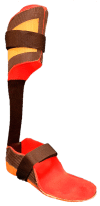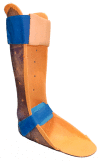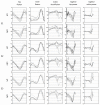Effect of Ankle-Foot Orthoses in Pediatric Patients with Hereditary Motor-Sensory Neuropathy: A Case Series Study
- PMID: 37761490
- PMCID: PMC10529230
- DOI: 10.3390/children10091529
Effect of Ankle-Foot Orthoses in Pediatric Patients with Hereditary Motor-Sensory Neuropathy: A Case Series Study
Abstract
(1) Aims: to evaluate the effect on gait performance and standing stability of ankle-foot orthoses (AFO) in pediatric patients with hereditary motor-sensory neuropathy (HMSN). (2) Methods: a retrospective case-series study including three adolescents (S1, S2, S3, mean age 14 years) with HMSN. The subjects were evaluated barefoot, with carbon AFO (Botter) and with solid AFO (SAFO) by means of: gait analysis, stabilometry and gait functional tests (10 Meter Walk Test, 2 Minute Walk Test). Finally, the CSD-OPUS questionnaire was administered to the assess satisfaction and impact of the orthoses on life quality. (3) Results: orthoses improved gait and stability performance. Botter allowed greater ankle movement than SAFO and provided greater push-off power. This, combined with the carbon elastic energy return, might explain better performances in the 2MWT, with a larger distance traveled compared to SAFO for both S1 (110 m vs. 72 m) and S2 (170 m vs. 155 m) and, compared to barefoot walking, also for S3 (211 m vs. 160 m), for which SAFO analysis was not available. Both orthoses improved performance at the stabilometric analysis. The CSD-OPUS questionnaire showed a significantly higher level of satisfaction with Botter for the subjects (S1, S2) who completed the comparison. (4) Conclusions: Both orthoses improved gait and standing, though Botter proved to be better tolerated and more effective in improving gait endurance.
Keywords: Gait Analysis; Hereditary Sensory And Motor Neuropathy; Orthotic Devices; Postural Balance; Rehabilitation.
Conflict of interest statement
The authors declare no conflict of interest.
Figures



References
-
- Howcroft D.W.J., Kumar S., Makwana N. Charcot Marie Tooth Disease. Orthop. Trauma. 2009;23:274–277. doi: 10.1016/j.mporth.2009.04.001. - DOI
Publication types
LinkOut - more resources
Full Text Sources

